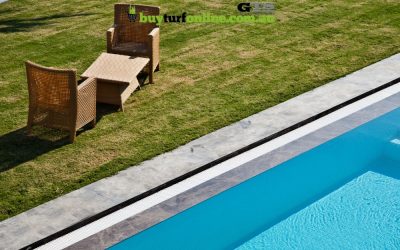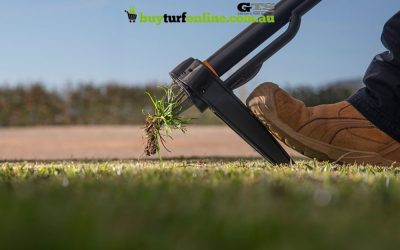How To Repair Zoysia Grass
Your Guide to Repairing Zoysia Grass
While Sir Grange Zoysia grass is easy to maintain, it’s still susceptible to damage.
Whether the damage is from harsh winters, thatch buildup or lawn disease, knowing how to repair your Zoysia lawn will keep it in top shape, no matter what nature throws at you.
A premium choice for your lawn, Sir Grange Zoysia grass boasts features such as a fine leaf blade, shade & drought tolerance, soft touch and low maintenance.
These features, which make Sir Grange such a popular turf choice, also mean that it requires particular care if your lawn experiences thinning or bare patches.
Why is my Sir Grange Zoysia Grass Dying?
If your Sir Grange Zoysia grass is turning yellow, thinning, or showing signs of decline, there could be several underlying causes.
Issues like poor soil quality, pH imbalances, or improper watering practices can severely impact your lawn’s health.
Compacted soil and excessive thatch buildup might also be restricting root growth and access to essential nutrients. Additionally, pests like armyworms or diseases such as brown patch could be damaging your turf.
To dive deeper into the reasons your Sir Grange Zoysia might be suffering and how to identify these problems, check out our detailed guide on why your Sir Grange Zoysia grass may be dying.
Understanding Common Issues with Sir Grange Zoysia Lawns
As a premium choice, Sir Grange Zoysia requires far less maintenance than other varieties. It is extremely drought tolerant, requiring 50% less water than other lawns.
And, while a Sir Grange lawn requires regular mowing for healthy growth, the frequency of mowing required is far less. Considering this, here are some of the most common problems that Sir Grange lawn owners face.
Overwatering in shady areas
While Sir Grange grass is extremely shade-tolerant, it can struggle with overwatering in shady areas. If your lawn is being overwatered, you’ll notice that it starts to thin out and struggle to grow in shaded areas.
While regular watering is important, it’s key to also watch how much water you’re lawn receives. If it has been raining recently, your lawn may not need additional watering.
And, in shaded areas of your lawn, you may consider reducing how much water you provide, especially over autumn & winter.
Compaction and poor soil quality
Even healthy grass can struggle to grow without the air, water or nutrients it requires. And, soil health will directly impact how your lawn’s roots receive these key elements needed for growth.
Compacted soil can lead to roots struggling to receive the air it needs, while hydrophobic soil will expell necessary water (whether its rainfall or from the sprinkler).
Additionally, a soil that has the wrong pH level or is lacking in nutrients will limit a lawn’s ability to thrive.
If your Sir Grange Zoysia grass is no longer actively growing, you may find that the soil base could be limiting its growth.
Pest and disease problems
Despite a natural resilience to pests and diseases, Sir Grange Zoysia lawns are still susceptible to the damage caused by pests and lawn diseases.
Common pests to look out for are armyworms and the beetles which will start to eat through the leaf blade or roots of your grass, leading to dying and bare spots in your lawn.
Common lawn diseases that can damage Sir Grange Zoysia include brown patch and dollar spot. While distinct lawn diseases, your lawn is more susceptible to disease when it has been overwatered or watered at the wrong time of day.
Wear and tear
Being a slower-growing grass type, Sir Grange offers many benefits such as less water and nutrient requirements as well as less maintenance.
However, it also means it can be slow to bounce back from wear and tear damage.
Wear and tear damage can be caused by frequent foot traffic over the same patch of grass, or from lawn furniture remaining on the same place in your lawn.
With the right Sir Grange Zoysia grass maintenance, your lawn should be less susceptible from wear and tear damage and remain resilient year round.
First, Assess the Damage
If you find that your Sir Grange Zoysia lawn is starting to look worse for wear, you should first assess the damage and signs of distress. Without stopping to consider what is causing the issue, you may find you cause more damage.
The best place to start is with a visual inspection. Look for thinning, yellowing, bare patches, and other stress signs. Each of these indicators will be able to give you a better idea if the issue is overwatering, lawn disease or something else.
Next, it’s always a good idea to do a soil test if you haven’t recently. Check if it’s the pH levels or nutrient deficiencies that might be contributing to poor lawn health.
How to Repair Sir Grange Zoysia Lawn
Once you have an idea of what is causing your issue, you can then start to address it. Here are some of the most common ways to repair a Sir Grange Zoysia lawn.
Aeration and topdressing
Aeration plays a vital role in repairing a damaged Sir Grange Zoysia lawn by addressing compacted areas where the soil has been compressed, limiting root growth and water infiltration.
Aeration relieves this compaction by creating small holes that improve the flow of water, nutrients, and oxygen to the roots, helping them recover.
Following aeration, topdressing with quality soil enhances the repair process. A fine layer of nutrient-rich soil fills any low spots, promotes better soil structure, and encourages new growth, allowing damaged areas to heal more quickly and uniformly.
Filling Bare Spots in Zoysia grass
When repairing a Sir Grange Zoysia lawn, filling bare spots with new turf is often a more efficient method than overseeding, particularly due to Zoysia’s slow growth rate.
Bare patches can become weak points in the lawn, susceptible to weeds and erosion if left untreated for too long. While overseeding may eventually fill in the gaps, laying fresh Sir Grange turf provides an immediate fix, ensuring these areas are covered and protected.
Fertilising with the right nutrients
A damaged Sir Grange Zoysia lawn needs the right nutrients to recover, and applying a balanced, slow-release fertiliser is key.
These fertilisers supply essential nutrients like nitrogen, phosphorus, and potassium in a steady stream, helping to rejuvenate weakened areas of the lawn.
Proper fertilisation encourages new growth, strengthens the grass’s root system, and enhances its ability to resist future stress. Find out more about fertilising Sir Grange Zoysia grass.
Manage weeds, pests, and diseases
To control weeds, use a post-emergent herbicide safe for Zoysia, targeting specific weed types without harming the grass.
However, we always recommend a you apply pre-emergent herbicides before the growing season to stop common weeds like crabgrass from germinating. Read more about choosing a weed killer for Sir Grange Zoysia grass.
If you find signs of common pests like armyworms or grubs, ensure you maintain good lawn care practices (including proper mowing and watering) and apply selective insecticide or pesticide to erradicate any pests.
Finally, you can target any fungal infections like brown patch or dollar spot by applying a fungicide.
Then, to minimise future outbreaks you can reduce thatch through aeration, improve air circulation, and avoid overwatering.
read more!
recent posts
Poolside Turf: Choosing and Maintaining Grass Around Pools
There’s nothing quite like stepping out of a swimming pool onto soft, lush grass. But when it comes to finding the best grass for around a pool, not all lawns are created equal. Chlorine pools, heavy foot traffic, and the unforgiving Australian sun can take a toll on...
Keeping Your Lawn Green and Healthy During the Summer Heat
Discover the best grass options for your lawn with our complete guide. Make informed choices for a lush, healthy yard. Read more to find your ideal grass!
Summer Lawn Weeds: Prevention and Management
Discover the best grass options for your lawn with our complete guide. Make informed choices for a lush, healthy yard. Read more to find your ideal grass!

Our Turf
TifTuf Bermuda
Buy Turf Online © 2019 All Rights Reserved. | Proudly Designed and Developed by Sydney ICT



